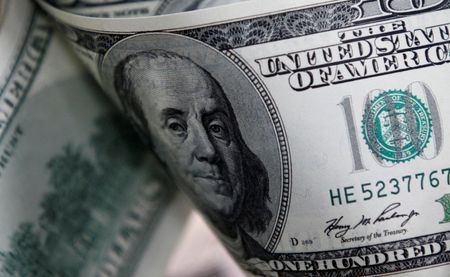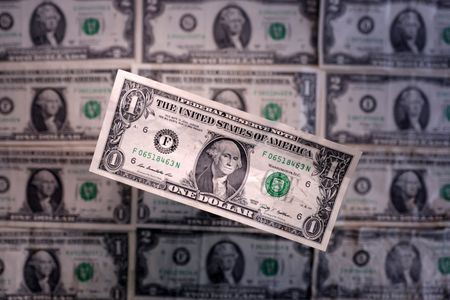By Kevin Buckland and Stefano Rebaudo
(Reuters) -The Australian dollar fell towards a four-month low on Tuesday after the central bank softened its tone on the inflation outlook, raising expectations for an earlier interest rate cut.
The U.S. dollar was steady against its major rivals and edged to its strongest this month versus the yen as traders looked ahead to a U.S. inflation reading on Wednesday for further clues on the pace of Federal Reserve easing.
The Aussie fell 0.84% to $0.6387 as of 0820 GMT, and earlier dipped to $0.6380, in striking distance of Friday’s low of $0.6373, a level that had not been seen since Aug. 5.
It rose 0.8% the day before after China pledged an “appropriately loose” monetary policy next year.
The New Zealand dollar dropped in sympathy, declining 0.75% to $0.5820.
The Reserve Bank of Australia held rates steady as widely expected, but noted the board had gained “some confidence” that inflation was heading back to target.
The statement omitted a previous line that the RBA was “not ruling anything in or out”, as well as policy needing to remain restrictive.
“A full pricing-in (of a rate cut) over the next few weeks would weigh further on the Australian dollar,” said Volkmar Baur, forex strategist at Commerzbank, recalling that two labour market reports and the inflation figures for the fourth quarter will be published before the next policy meeting in February.
Swaps now imply there is a 54% chance of a rate cut in February, with a first easing more than fully priced in by April next year.
“While a downside surprise in the fourth quarter inflation could trigger a February rate cut, we think the continued tightness of the labour market and a pick-up in consumption growth point to the Bank only easing at its May meeting,” said Marcel Thieliant, head of Asia Pacific at Capital Economics.
The U.S. dollar rose 0.3% to 151.60 yen after earlier climbing to 151.71 yen for the first time since Nov. 28.
The dollar index, which measures the currency against the yen and five other major peers, rose 0.1% to 106.28.
It had climbed to a two-year peak of 108.09 on Nov. 22, lifted by expectations that Donald Trump’s election victory would drive U.S. growth and stoke inflation, potentially slowing Fed rate cuts.
While markets have priced in a quarter-point Fed rate cut on Dec. 18 as a near certainty, the consumer price index due on Wednesday could shine light on how much room policymakers have for easing next year.
Market participants see little action before a busy second half of the week with the U.S. data and the European Central Bank policy meeting.
An ECB quarter-point cut is baked in, but analysts will focus on the communication, which could provide clues about the central bank’s future moves.
They flagged that the ECB could remove the reference to the need to keep policy rates “sufficiently restrictive”, while President Christine Lagarde might say in the press conference that inflation is broadly on track to fall to the target.
The euro dropped 0.1% to $1.0544, while sterling fell 0.05% to $1.2739.
Investors will closely watch China’s closed-door Central Economic Work Conference, which sets key targets and policy intentions for next year.
The yuan strengthened about 0.20% to 7.2529 per dollar in offshore trading, supported by Monday’s surprise shift in Beijing’s monetary policy stance toward more easing to boost the ailing economy.
The currency shrugged off data showing Chinese exports slowed more than expected last month and imports unexpectedly shrank.
Elsewhere, the Bank of Canada and the Swiss National Bank decide policy on Wednesday and Thursday, respectively, with deep rate cuts expected from both.
Against Canada’s loonie, the U.S. dollar rose to its strongest level since April 2020 at C$1.41895.
The U.S. currency declined 0.04% to 0.8792 Swiss franc.
(Reporting by Kevin Buckland; Editing by Shri Navaratnam, Kim Coghill, Jamie Freed and Ed Osmond)











